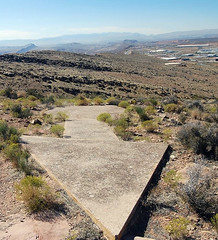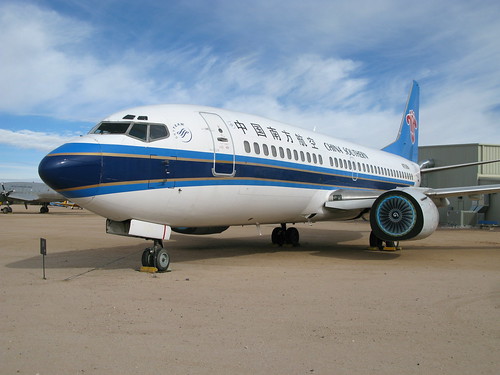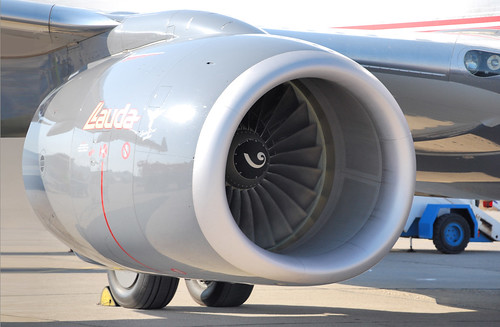 A few weeks ago I posted an entry about Lindy lights, the light beacons that helped airmail pilots in the 1920s and 30s navigate at night. A friend sent me a link to another blogger’s post about early aerial navigation aids. Did you know that in addition to the beacon lights, there were also giant concrete arrows on the ground? And that some are still left? Makes you want to go exploring, doesn’t it?
A few weeks ago I posted an entry about Lindy lights, the light beacons that helped airmail pilots in the 1920s and 30s navigate at night. A friend sent me a link to another blogger’s post about early aerial navigation aids. Did you know that in addition to the beacon lights, there were also giant concrete arrows on the ground? And that some are still left? Makes you want to go exploring, doesn’t it?
Speaking of aerial navigation, last night a Boeing 747 freighter landed at the wrong airport. Thinking they were lined up for approach to McConnell Air Force Base in Wichita, Kansas, the pilots landed instead at Jabara Airport, a few miles away. Complicating matters, the runway at Jabara, meant to accommodate light aircraft, is not long enough for the B747 to take off again. When I first heard the story, I thought they might have to unload the cargo at Jabara, disassemble the B747, truck it in pieces across town to McConnell, then reassemble it before it could fly again: a costly mistake indeed.
But not so fast: today the plane’s operators determined that as long as they didn’t refuel it, the B747 would be light enough to make a just-barely-legal takeoff for the very short hop to McConnell, so it’s not as big a problem as it first appeared to be. In fact they’ve already flown it to McConnell. No word of whether they trusted the original crew to make that flight, or whether they had to offload some or all of the cargo first.
Wrong-airport landings are not as rare as you may think. There are several locations where military and civilian airfields lie in close proximity to each other, and in cases where the runways at both fields are oriented the same way, inattentive pilots can easily fall into the trap, lining up for landing at one airport on instruments 20 or 30 miles out, then glomming onto the other airport visually. With an airfield in sight, and in approximately the correct position, it’s surprisingly easy to take it all the way to touchdown before realizing what you’ve done.
When two large airports are close together, approach and tower controllers for both fields are alert to the possibility and are quick to warn erring pilots. Sadly, Jabara Airport is uncontrolled and there was no one there to tell the B747 crew they were about to land at the wrong field.
Believe me, I’m not laughing at these guys. I’ve come close to doing it myself. I was flying into McChord AFB in Seattle, lined up on the ILS but still in the clouds. When I got below the weather 15 miles out and looked ahead the first thing I saw was Seattle/Tacoma International Airport. Sea/Tac is a few miles east and north of McChord, but at that distance it was where I expected McChord to be, so I started steering for it. After a couple of miles I noticed the ILS telling me to turn left. I looked 10 degrees to the left, saw McChord, and realized my mistake. I later learned that over the years dozens of McChord-bound USAF planes have landed at Sea/Tac. I might easily have been one of them.
While I can understand a B747 freighter crew landing at the wrong airport, I can’t begin to divine what could have caused the crew of that Tatarstan Airlines Boeing 737 to nosedive into the ground at Kazan Airport in Tatarstan, Russia on the night of November 18th, killing 50. Spatial disorientation? Catastrophic control failure? Suicide? How utterly horrifying.
As you know, I volunteer at the Pima Air & Space Museum here in Tucson, Arizona. I’m super-proud of our volunteer restoration team and always point out examples of their work to museum visitors. I’m not so proud of what they’ve done with our latest acquisition, however. Here’s a photo:

Take a closer look at that “engine”:

Yes, that is what you think it is: a flat wooden panel with fan blades and a hub painted on it. This is a real B737 engine:

Our new exhibit, a retired B737-300 that had flown out its airframe life, was given to us by Boeing … without its engines. For several months it’s been hidden from public view while the restoration team tried to find engines to put in the empty nacelles. My understanding was that the airplane wouldn’t go on display until it was complete. Nevertheless, they’ve put it on display without engines, I think because Boeing executives scheduled a turnover ceremony earlier this month and couldn’t wait until later.
Some of our military exhibits don’t have engines, but plugs placed inside inlets and exhausts disguise their absence. In this case, though, the forward section of each engine nacelle is also missing, making the flat painted panels look cheap and fakey, worthy of a children’s amusement park display but not a respectable aviation museum. I’m terribly disappointed in this exhibit and hope that now the Boeing executives are gone our restoration team will tow it away and park it out of sight until they find the missing bits.